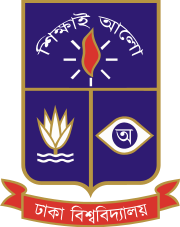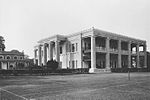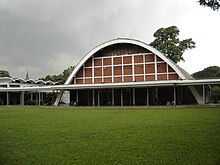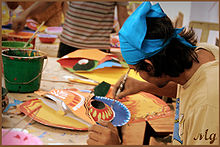This is an old revision of this page, as edited by Archon 2488 (talk | contribs) at 13:07, 8 August 2015 (style). The present address (URL) is a permanent link to this revision, which may differ significantly from the current revision.
Revision as of 13:07, 8 August 2015 by Archon 2488 (talk | contribs) (style)(diff) ← Previous revision | Latest revision (diff) | Newer revision → (diff)| ঢাকা বিশ্ববিদ্যালয় | |
 | |
| Motto | Error: {{Lang}}: text has italic markup (help) (Bengali) |
|---|---|
| Motto in English | Truth Will Prevail |
| Type | Public, Coeducational |
| Established | 1921 |
| Chancellor | Abdul Hamid |
| Vice-Chancellor | AAMS Arefin Siddique |
| Academic staff | 3,408 |
| Students | 37,800 |
| Location | Dhaka, |
| Campus | Urban, 240 hectares (600 acres) (without the Institute of leather engineering and tech.) |
| Website | www.du.ac.bd; www.univdhaka.edu |
 | |
The University of Dhaka (Template:Lang-bn Template:IPA-bn, also known as Dhaka University or simply DU), is the oldest university in modern Bangladesh. Established during the British Raj in 1921, it gained a reputation as the "Oxford of the East" during its early years and has been a significant contributor to the modern history of Bangladesh. After the partition of India, it became the focal point of progressive and democratic movements in Pakistan. Its students and teachers played a central role in the rise of Bengali nationalism and the independence of Bangladesh.
The university's distinguished alumni include Satyendra Nath Bose (pioneer of Bose–Einstein statistics), Fazlur Rahman Khan (pioneer of modern structural engineering), Muhammad Yunus (winner of the 2006 Nobel Peace Prize), Vijayaraghavan (co-discoverer of the PV number), Muhammad Shahidullah(Famous educator, philologist and linguist), Rehman Sobhan (social democratic economist), Buddhadeb Bose (20th century Bengali poet) and Sheikh Mujibur Rahman (the founding father of Bangladesh). It also enjoyed associations with Kazi Nazrul Islam, Rabindranath Tagore and Faiz Ahmed Faiz.
Today, it is the largest public university in Bangladesh, with a student body of 33,000 and a faculty of 1,800. It was identified by AsiaWeek as one of the top 100 universities in Asia. However since the 1990s, the university has suffered from intensely politicized, partisan and violent campus politics promoted by Bangladesh's political parties.
History
 Earliest Bachelor of Arts certificate from the University, 1928
Earliest Bachelor of Arts certificate from the University, 1928 1904 image of Dhaka College, which was in existence from 1841 to 1921 before the founding of Dhaka University
1904 image of Dhaka College, which was in existence from 1841 to 1921 before the founding of Dhaka University
Before Dhaka University was established, near its grounds were the former buildings of Dhaka College. But in 1873 the college was relocated to Bahadur Shah Park. Later it shifted to Curzon Hall, which would later become the first institute of the University of Dhaka.
The establishment of the university was a compensation of the annulment of the 1905 Partition of Bengal. The partition had established East Bengal and Assam as a separate province, with Dhaka as its capital. However, the partition was abolished in 1911 due to severe opposition from Indian National Congress and Bengali Hindus. To appease the people of East Bengal, Lord Curzon declared that a university as a center of excellence would be established in Dacca. Khwaja Salimullah, the Nawab of Dhaka, also played a pioneering role in establishing a university in Dhaka.
In 1913, public opinion was invited before the university scheme was given its final shape. The secretary of state approved it in December 1913. The first vice-chancellor of the university, Dr. Philip Joseph Hartog, formerly academic registrar of the University of London for 17 years was appointed. During the opening of the University, Joseph Hartog made this speech in honour of the university:
"A man may be an excellent teacher of elementary subjects without the power to add to knowledge. But in advanced work I maintain that no one can really teach well unless he has the combination of imagination with critical power which leads to the original production (of knowledge), and for that if for no other reason, a university to be a true university must see that its teachers are men who are also capable of advancing knowledge."
— Philip Joseph Hartog, during the second convocation of the university
Established in 1921 under the Dacca University Act 1920 of the Indian Legislative Council, it is modelled after British universities. Academic activities started on July 1, 1921 with 3 Faculties: Arts, Science and Law; 12 Departments: Sanskrit and Bengali, English, Education, History, Arabic and Islamic Studies, Persian and Urdu, Philosophy, Economics and Politics, Physics, Chemistry, Mathematics, and Law; 3 Dormitories for students: Salimullah Muslim Hall, Dacca Hall and Jagannath Hall.
The university later played a significant role in the Bengali Language Movement, when Bengalis joined together to fight against Urdu being the official language in East Pakistan. Dhaka University was the main place where the movement started with the students joining together and protesting against the Pakistan government. Later countless students were massacred in where the Shaheed Minar stands today. After the incident, Bengali was restored as official language.
The Dhaka University Order, 1973
President's order no. 11 OF 1973 re-constitute and re-organize the University of Dhaka for the purpose of improving the teaching and research provided thereby and the administration after 1971 Independence war. Throughout this Order the word Dhaka was substituted for the word Dacca by section 2 of the University Laws (Amendment) Act, 1987 (Act No. XXXVI of 1987)
Academic departments





The university has 70 departments under 13 faculties. The faculties are:
Faculty of Arts
- Department of Arabic
- Department of Bengali
- Department of English
- Department of Persian Language and Literature
- Department of History
- Department of Philosophy
- Department of Islamic Studies
- Department of Pali and Buddhist Studies
- Department of Sanskrit
- Department of Urdu
- Department of Theater and Performance Studies
- Department of Linguistics
- Department of Music
- Department of Islamic History and Culture
- Department of World Religions and Culture
- Department of Information Science and Library Management
Faculty of Business Studies
- Department of Finance
- Department of Accounting and Information System (AIS)
- Department of Marketing
- Department of Management
- Department of Banking and Insurance
- Department of Management Information System (MIS)
- Department of International Business
- Department of Tourism and Hospitality Management
Faculty of Biological Science
- Department of Botany
- Department of Soil, Water and Environment
- Department of Microbiology
- Department of Biochemistry and Molecular Biology
- Department of Fisheries
- Department of Genetic Engineering and Bio-technology
- Department of Psychology
- Department of Clinical Psychology
- Department of Zoology
- Department of Educational and Counseling Psychology
Faculty of Engineering and Technology
- Department of Electrical & Electronic Engineering (Former Department of Applied Physics, Electronics & Communication Engineering)
- Department of Applied Chemistry and Chemical Engineering
- Department of Computer Science and Engineering
- Department of Nuclear Engineering
Faculty of Education
- Technical Teachers' Training College (Technical Education)
Faculty of Fine Arts
- Department of Crafts
- Department of Drawing and Painting
- Department of Graphic Design
- Department of Printmaking
- Department of Oriental Art
- Department of Sculpture
- Department of History of Art
- Department of Ceramics
Faculty of Law
- Department of Law
Faculty of Medicine
Faculty of Postgraduates Medical Sciences & Research
Faculty of Pharmacy
- Department of Pharmaceutical Chemistry
- Department of Clinical Pharmacy and Pharmacology
- Department of Pharmaceutical Technology
Faculty of Science
- Department of Chemistry
- Department of Physics
- Department of Mathematics
- Department of Statistics, Biostatistics & Informatics
- Department of Theoretical Physics
- Department of Biomedical Physics and Technology
- Department of Applied Mathematics
Faculty of Social Sciences
- Department of Anthropology
- Department of Criminology
- Department of Development Studies
- Department of Economics
- Department of International Relations
- Department of Sociology
- Department of Mass Communication and Journalism
- Department of Population Sciences
- Department of Political Science
- Department of Public Administration
- Department of Peace and Conflict Studies
- Department of Women's and Gender Studies
- Department of Television and Film Studies
Faculty of Earth and Environmental Sciences
- Department of Geography and Environment
- Department of Geology
- Department of Oceanography
- Department of Disaster Science and Management
Institutes
See also: List of colleges under University of Dhaka
- Institute of Education and Research
- Institute of Statistical Research and Training
- Institute of Business Administration
- Institute of Nutrition and Food Science
- Institute of Social Welfare and Research
- Institute of Modern Languages
- Institute of Health Economics (http://www.ihe.ac.bd/)
- Institute of Information Technology
- Institute of Renewable Energy
- Institute of Disaster Management and Vulnerability Studies
- Institute of Leather Engineering & Technology
Bureaus and research centers
|
|

Trusts, foundations and scholarship programs
The University contains about 220 trusts and foundations offering scholarships and medals to meritorious students of the University. Besides, a large number of scholarships are also offered by the University, Dhaka University Alumni Association and the Government.
Residence halls

- A.F. Rahman Hall
- Amar Ekushey Hall
- Bangabandhu Sheikh Mujibur Rahman Hall
- Bangladesh-Kuwait Maitree Hall
- Begum Fazilatunesa Mujib Hall
- Bijoy Ekattor Hall
- Fazlul Haq Muslim Hall
- Haji Muhammad Mohshin Hall
- IBA Hostel
- ILET Hostel
- Jagannath Hall
- Kabi Jashimuddin Hall
- Kabi Sufiya Kamal Hall
- Muktijoddha Ziaur Rahman Hall
- Nawab Faizunnessa Chowdhurani Chhatrinibash (Hostel)
- Ruqayyah Hall
- Salimullah Muslim Hall
- Sergent Zahurul Haq Hall
- Shahidullah Hall
- Shahnewaz Hostel
- Shamsunnahar Hall
- Sir P.J. Hartog International Hall
- Surya Sen Hall
Library
The University Library, housed in three separate buildings, is the biggest in Bangladesh. The Library holds a collection of more than 617,000 volumes, including bound volumes of periodicals. In addition, it has a collection of over 30,000 manuscripts on various languages and a large number of microfilms, microfiche and CDs. It subscribes to over 300 current foreign journals.
The Dhaka University Library comprises three buildings: The administrative building, the main library building, and the science library building. The administrative building has the administrative offices, a book acquisition section, a book processing section, a reprographic section, a book binding section, a manuscript section, and a seminar section.
Health services
The Medical Center of the University of Dhaka, located near the Science Annex Building, offers free medical service and free pathological examinations to students, teachers and staffs of the University and also family members of the teachers and staffs. The Centre provides service round the clock, seven days a week, with 30 doctors working in different shifts. The Centre also has dental unit, eye unit, x-ray department and two ambulances. The Centre has in its premises arrangement for 30 bed accommodation so that students suffering from such contagious diseases as chicken pox, mumps, etc. may be taken care of in isolation.
Sports and extracurricular activities
University of Dhaka organizes sports and other extracurricular and recreational activities. Office of the director of physical education provides three types of programs:
- Compulsory Physical Education,
- Certificate course in coaching major games and sports, and
- Intramural and extramural programs.
University of Dhaka ground is the official stadium of the University of Dhaka. It hosts many inter-collegiate sports tournaments at inter-city and national levels.
Intramural and extramural program (games and sports)
Directorate also organizes and conducts interdepartmental and inter-hall tournaments, individual hall athletics, Dhaka university athletics, and inter- university games and sports. University students participate in national championships in different games and sports for which prior training and coaching are offered.
Cafeteria
There are some cafeterias on campus, some of which hold historical and architectural interest. In 1971 Pakistani soldiers killed the owner of the Madhur Canteen.



Ranking
International ranking
In 2014-2015, the University of Dhaka was ranked 701 by QS World University Rankings (formerly Times Higher Education–QS World University Rankings).
In 2011-2012, the University of Dhaka made it into the list of 'Top World Universities' in the ranking carried out by QS World University Rankings. Out of over 30,000 universities around the world, DU was placed at 551. In Engineering & IT the university positioned 100 th where in Life Sciences & Biomedicine the university ranked 284th.
However, the university ranked better in 2007 (within top 500) and 2006 (365th). The ranking in 2007 was: 336th in Arts & Humanities, 256th in Natural Sciences, 256th in Engineering & IT, 297th in Social Sciences and 251st in Life Sciences & Biomedicine.
Asian level ranking
in 2015-2016, the University of Dhaka was ranked 126 by QS Asian University Rankings.
In the best Asian (and Australian) universities ranking, AsiaWeek ranked the University of Dhaka 37th in 1999 and 64th (overall and multi-disciplinary category) out of 77 ranked universities in 2000.
In 2000, the university got a comparatively higher rank in student selectivity (23rd) while got lower ranking in academic reputation (74th), faculty resources (59th), research (65th) and financial resources (74) categories.
List of vice chancellors
- Sir. Philip Hartog: 1.12.1920-31.12.1925
- Professor G. H. Langley: 1.1.1926-30.6.1934
- Sir. A. F. Rahman : 1.7.1934-31.12.1936
- Dr. Ramesh Chandra Majumdar : 1.1.1937-30.6.1942
- Dr. Mahmud Hasan : 1.7.1942-21.10.1948
- Dr. S. M. Hossain : 22.10.1948-8.11.1953
- Dr. W. A. Jenkins: 9.11.1953-8.11.1956
- Justice Muhammad Ibrahim: 9.11.1956-27.10.1958
- Justice Hamoodur Rahman: 5.11.1958-14.12.1960
- Dr. Mahmud Hussain : 15.12.1960-19.2.1963
- Dr. Md. Osman Ghani 20.2.1963-1.12.1969
- Justice Abu Sayeed Chowdhury : 2.12.1969-20.1.1972
- Dr. Muzaffar Ahmed Chaudhury : 21.1.1972-12.4.1973
- Dr. Abdul Matin Chowdhury: 13.4.1973-22.9.1975
- Professor Muhammad Shamsul Huq : 23.9.1975-1.2.1976
- Dr. Fazlul Halim Chowdhury : 2.2.1976-20.3.1983
- Dr. A. K. M. Siddiq: 21.3.1983-16.8.1983
- Dr. Md. Shamsul Huq : 17.8.1983-12.1.1986
- Professor Abdul Mannan : 12.1.1986-22.3.1990
- Professor M. Maniruzzaman Miah : 24.3.1990-31.10.1992
- Professor Emajuddin Ahamed : 1.11.1992-31.8.1996
- Professor Shahid Uddin Ahmad : 31.8.1996-29.9.1996
- Professor A. K. Azad Chowdhury: 30.9.1996-12.11.2001
- Professor Anwarullah Chowdhury : 12.11.2001-31.7.2002
- Professor Dr. A.F. M. Yusuf Haider: August 1, 2002 – September 23, 2002.
- Professor Syed Mohammad Abul Faiz : 23.9.2002-16.1.2009
- Professor AAMS Arefin Siddique: 17.01.2009–present
Notable alumni and faculty members
Main article: Alumni and Faculty Members of University of DhakaSee also
23°43′53.57″N 90°23′32.99″E / 23.7315472°N 90.3924972°E / 23.7315472; 90.3924972
References
- "Mukherjee 'emotional' while receiving degree in Dhaka". The Economic Times. Retrieved January 4, 2014.
- "In Loving Memory of Samson H. Chowdhury,one of the greatest entrepreneurs the world has ever known". Worldfolio - AFA PRESS. Retrieved January 4, 2014.
- "Nawab Ali Chowdhury National Award, 2013". The News Today. Retrieved January 4, 2014.
- "DU Day". Banglanews24.com. Retrieved November 26, 2013.
- "TIME Magazine - Asia Edition - October 14, 2013 | Vol. 182, No. 16". Asiaweek.com. Retrieved 2013-10-08.
- "AFP: Student politics eroding Bangladesh campus life". Google.com. 2010-08-16. Retrieved 2013-10-08.
- Gordon Johnson, "Partition, Agitation and Congress: Bengal 1904 To 1908," Modern Asian Studies, (May 1973) 7#3 pp 533–588
- "Khwaja Salimullah". World History. Retrieved 14 May 2015.
- ^ Sajahan Miah (2012). "University of Dhaka". In Sirajul Islam and Ahmed A. Jamal (ed.). Banglapedia: National Encyclopedia of Bangladesh (Second ed.). Asiatic Society of Bangladesh.
- http://www.du.ac.bd/DownLoads/DU-Prospectus-2008.pdf
- DU going to launch New Department | BDUnilife.com
- "DU to establish research centre on '71 genocide". Dhaka Mirror. 2010-12-14. Retrieved 2013-11-14.
- "University of Dhaka". University-list.net. Retrieved 2015-07-28.
- "QS World University Rankings 2011 (501-600) -Top Universities". University-list.net. Retrieved 2013-10-08.
- "QS TopUniversities".(subscription required)
- "University of Dhaka". University-list.net. Retrieved 2015-07-28.
- "ASIANOW | The Asiaweek Best Universities 1999 | The Rankings - Bangladesh". Cgi.cnn.com. 1999-04-15. Retrieved 2013-11-14.
- "Asiaweek.com | Asia's Best Universities 2000 | Overall Ranking". Cgi.cnn.com. 2000-06-22. Retrieved 2013-10-08.
- "Asiaweek.com | Asia's Best Universities 2000 | University of Dhaka". Cgi.cnn.com. 2000-06-22. Retrieved 2013-11-14.
- "Hartog, Sir Philip Joseph". Banglapedia. Retrieved 18 March 2015.
- "Jenkins, Walter Allen". Banglapedia. Retrieved 18 March 2015.
- "Ibrahim, Justice Muhammad". Banglapedia. Retrieved 18 March 2015.
- "Rahman, Justice Hamoodur". Banglapedia. Retrieved 18 March 2015.
- "Ghani, M Osman". Banglapedia. Retrieved 18 March 2015.
- Metro Desk (2012-03-01). "Birth anniversary". Thedailystar.net. Retrieved 2013-11-14.
- "Chowdhury, Abdul Matin". Banglapedia. Retrieved 18 March 2015.
- "Professor A.K.M. Siddiq". Retrieved 18 March 2015.
- A. K. Azad Chowdhury
- "Department of Physics". Retrieved 18 March 2015.
External links
| University of Dhaka | |
|---|---|
| History | |
| Culture | |
| Institutes | |
| Facilities | |
| Residential halls | |
| Related | |
| International Conference on Computer and Information Technology | |
|---|---|